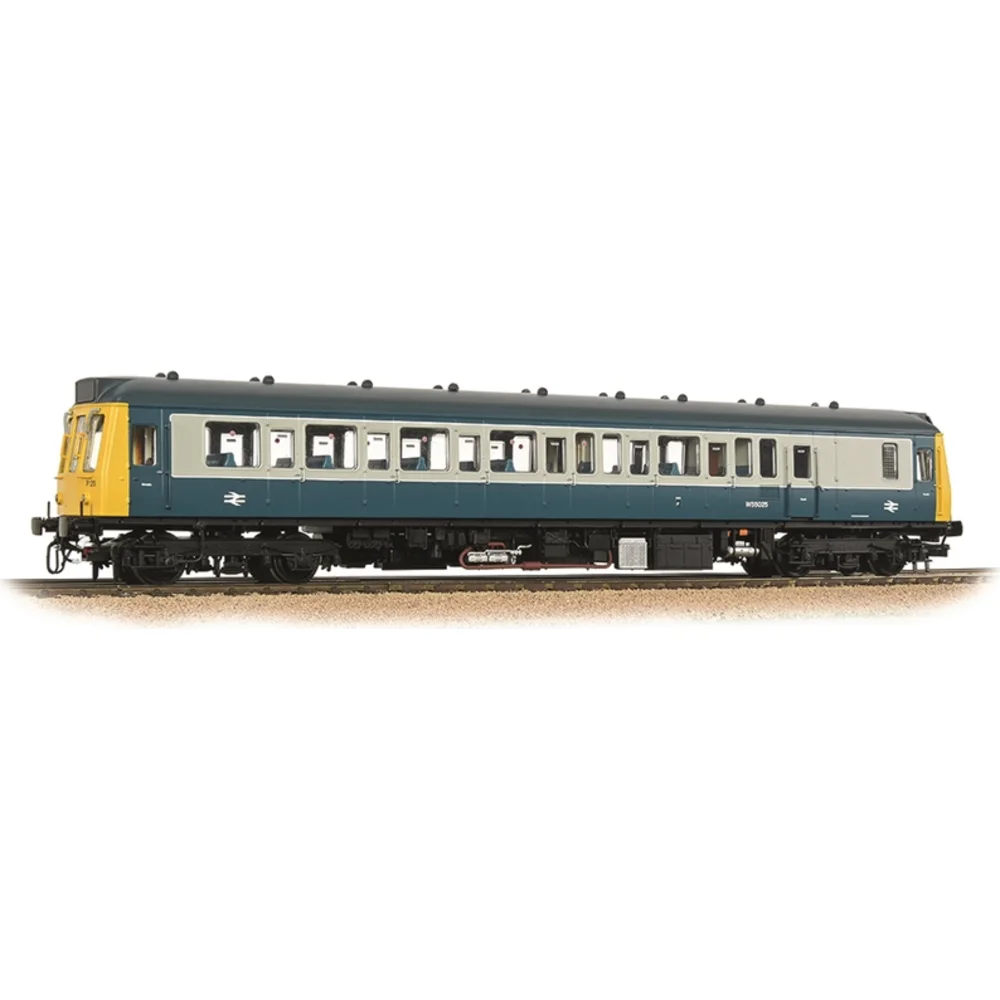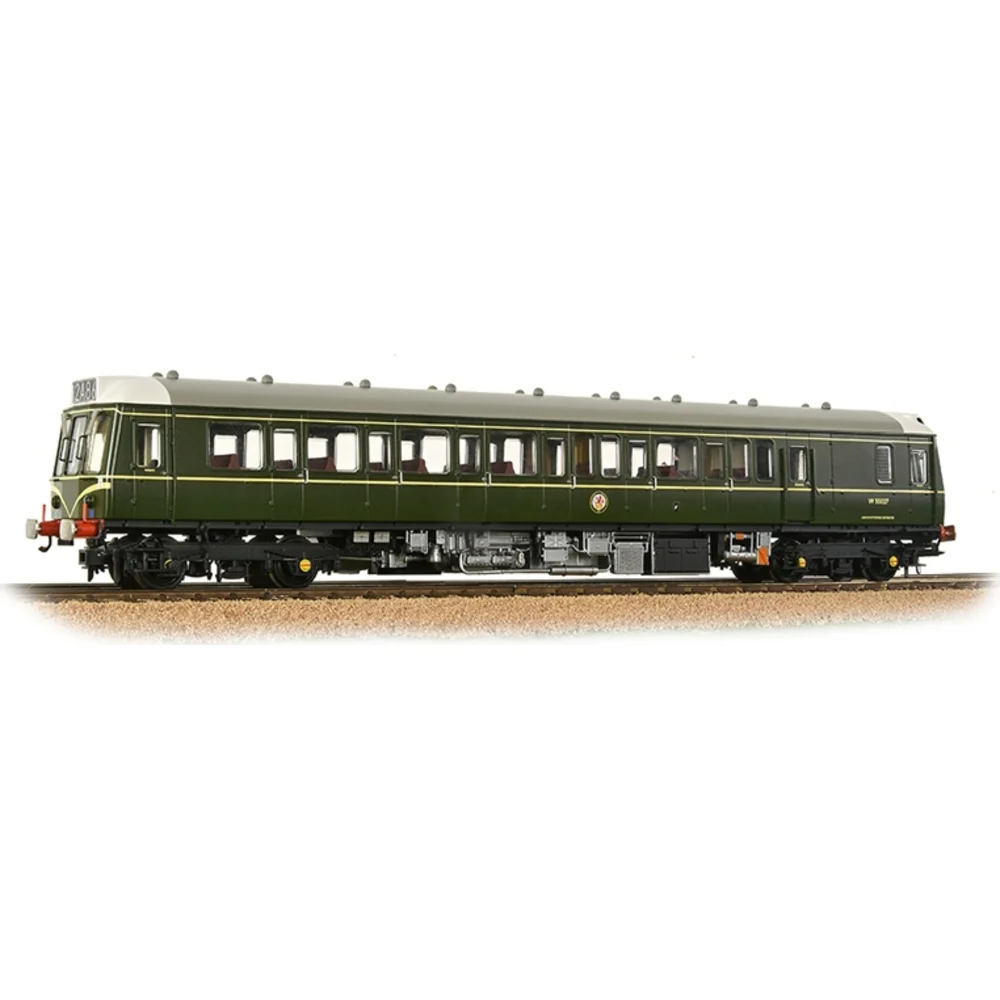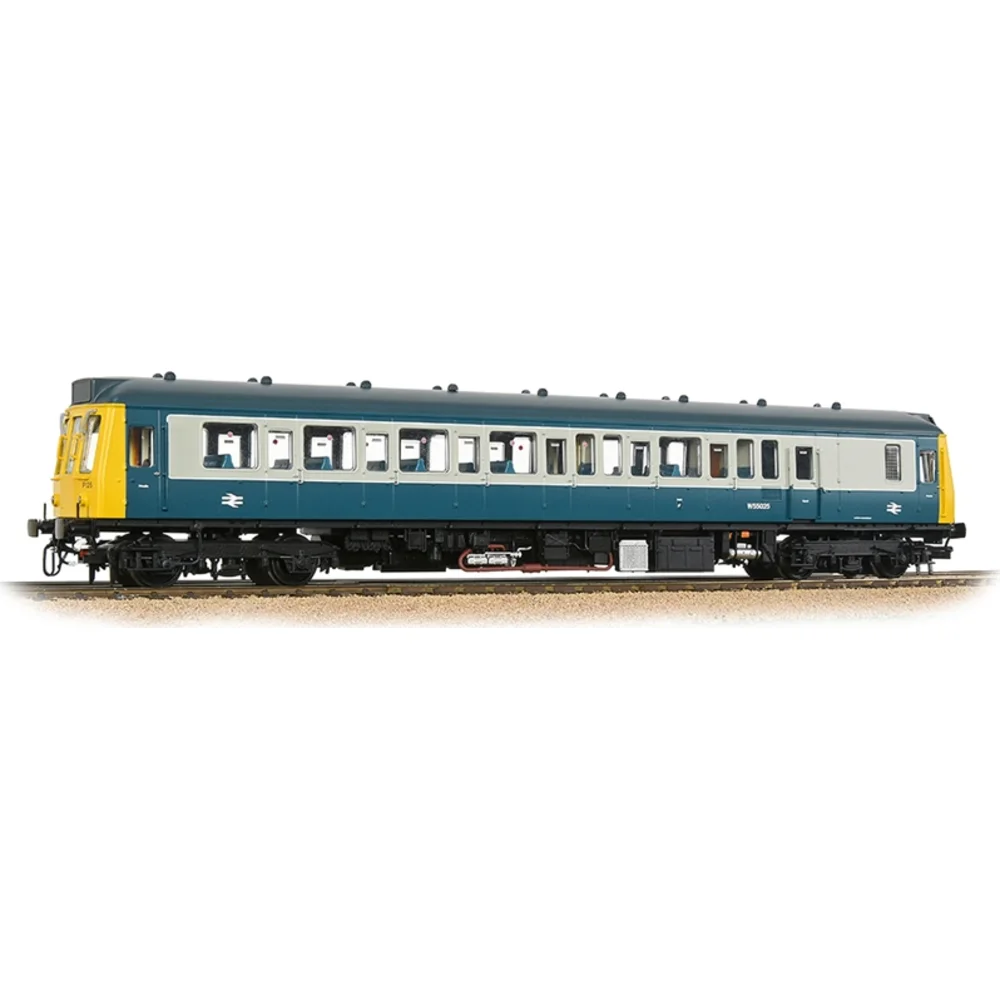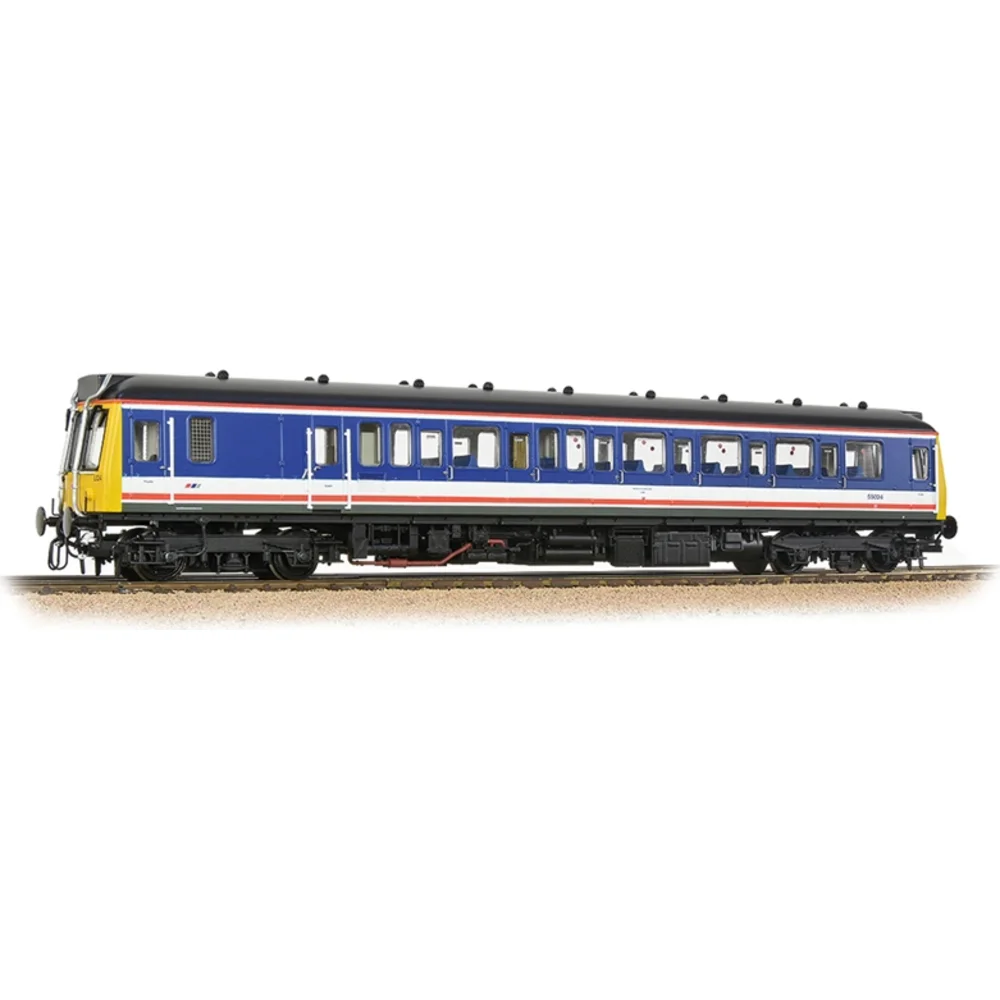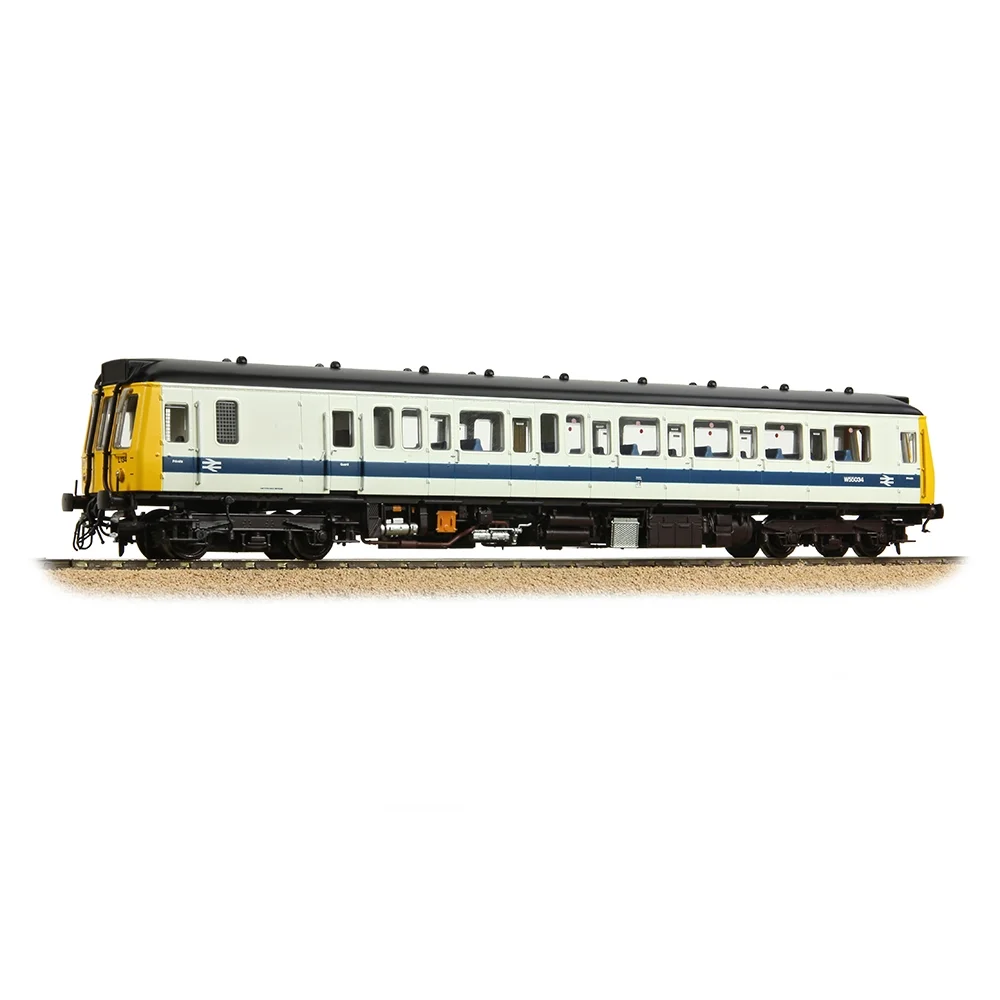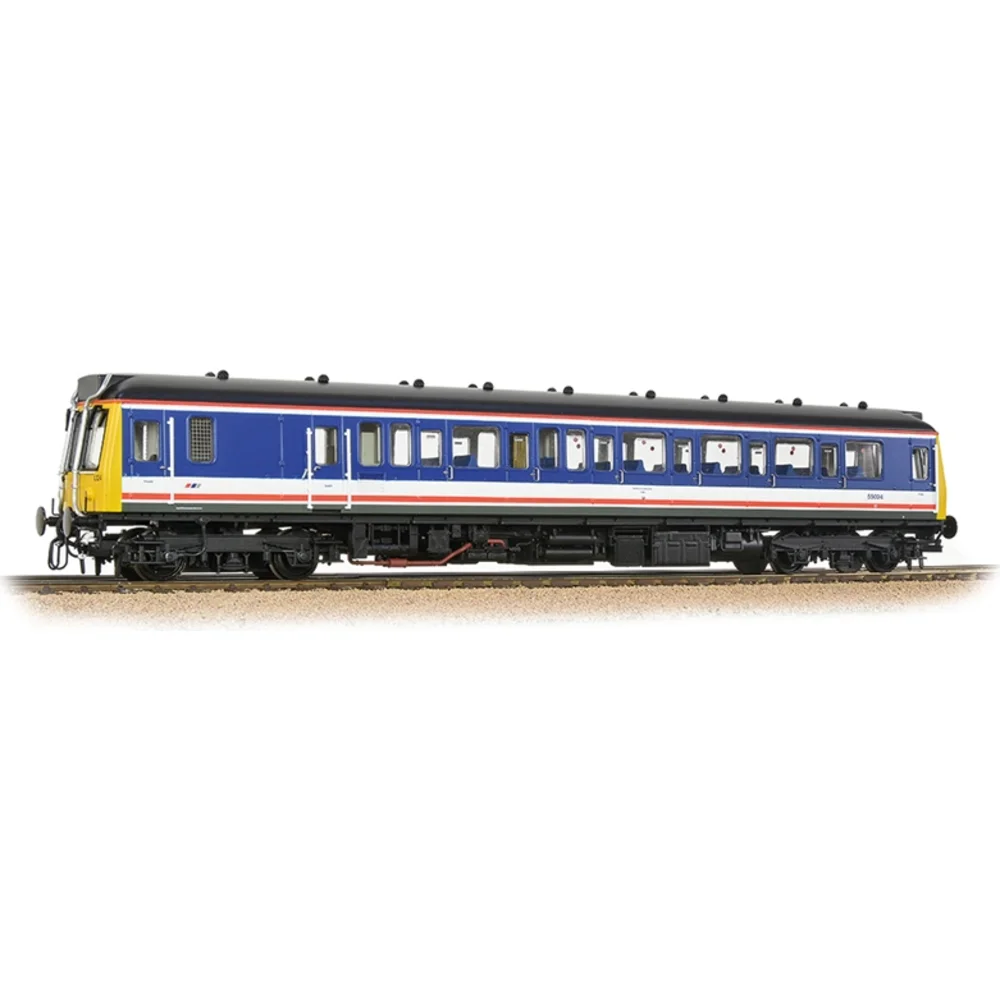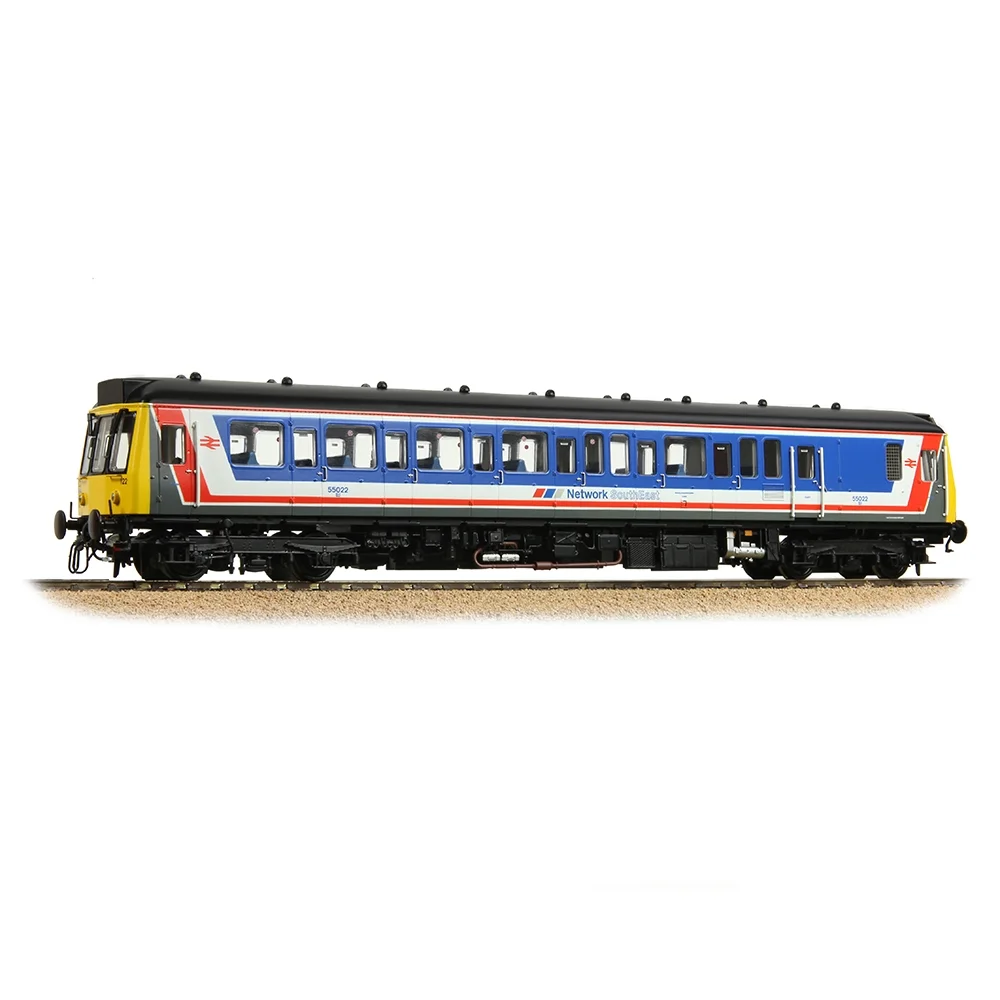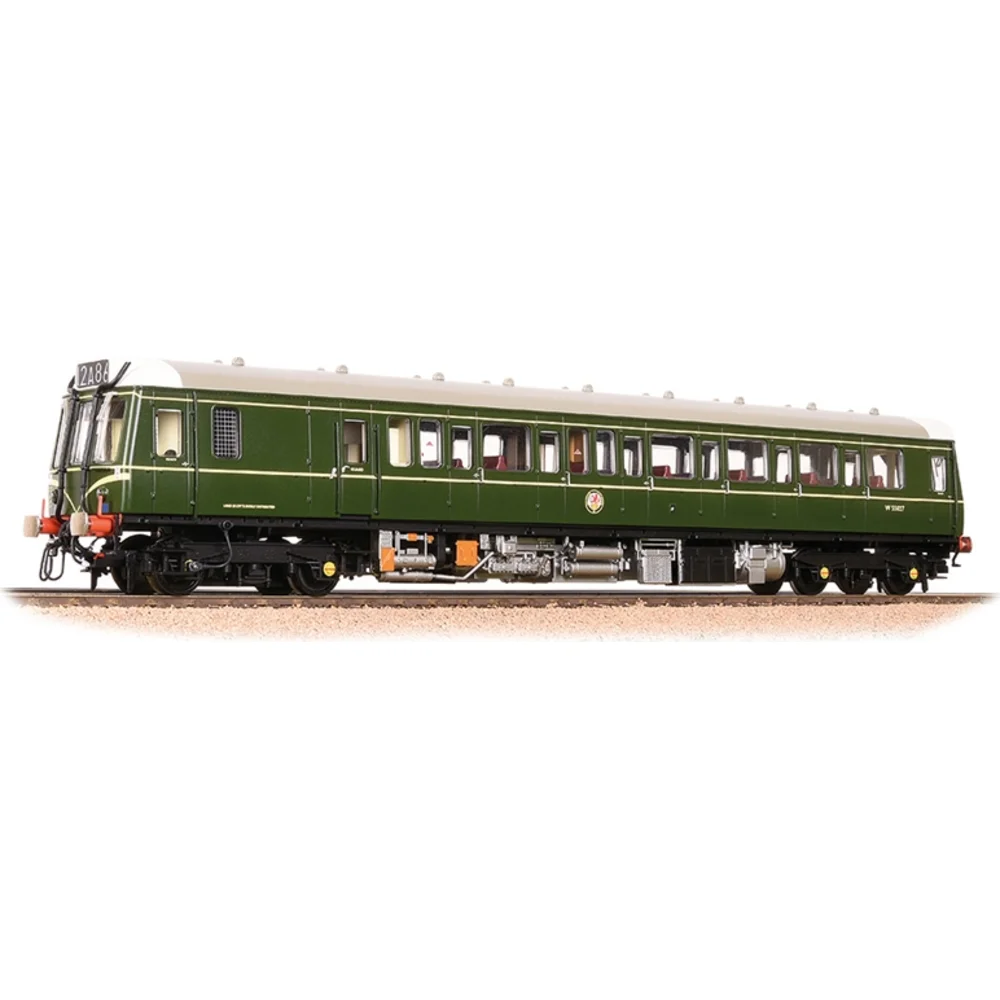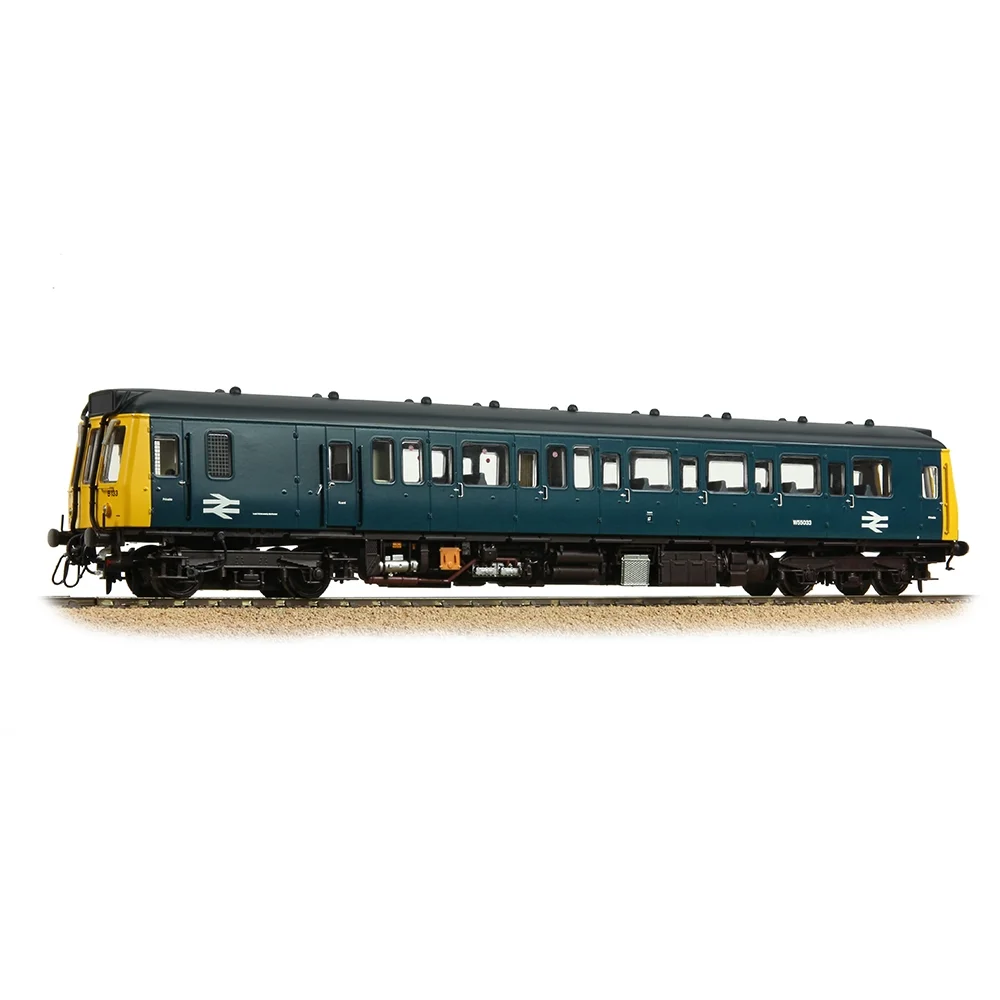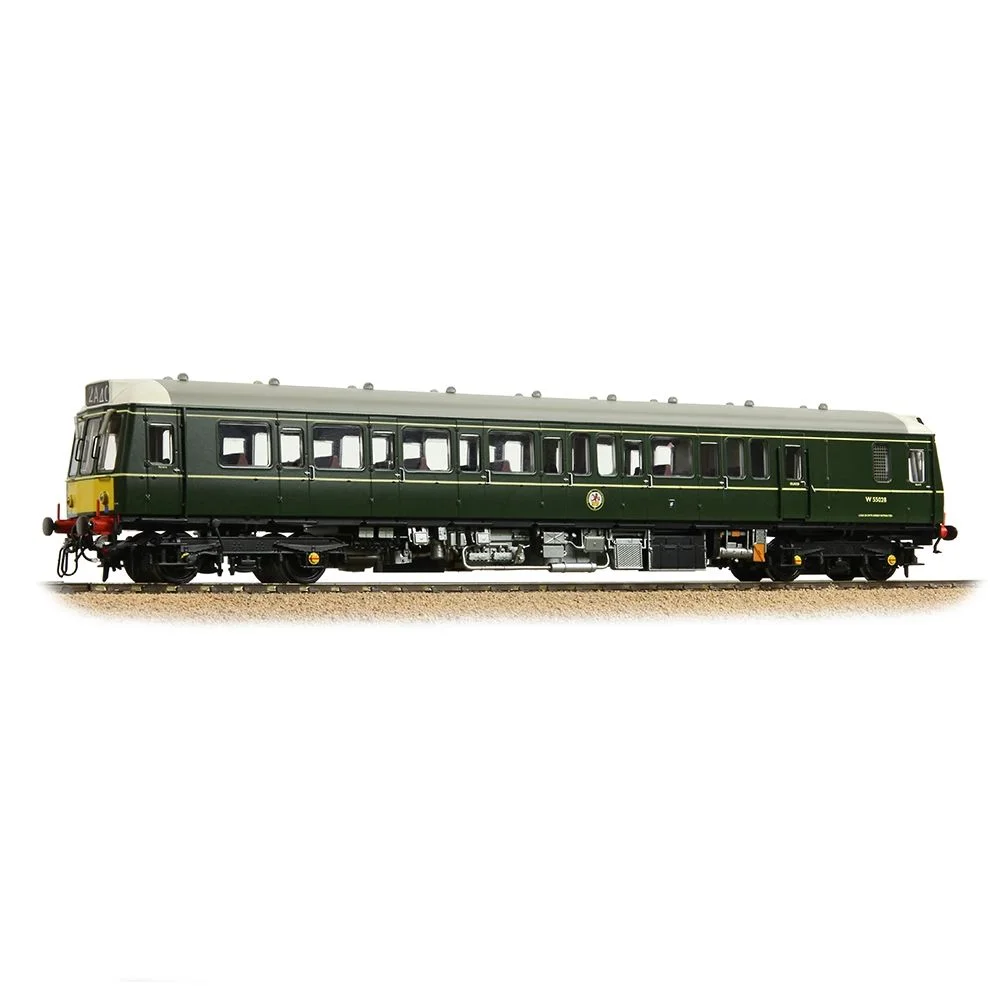British Rail Class 121 – Britain's Longest-Serving DMU and Branch Line Icon
Contents
The British Rail Class 121 holds the remarkable distinction of being Britain's longest-serving diesel multiple unit, operating continuously in passenger service for an extraordinary 57 years from 1960 to 2017. For model railway enthusiasts, this single-car "Bubble Car" represents one of the most versatile and authentic choices for recreating British branch line operations from the diesel transition era through privatisation. Built by Pressed Steel Company in 1960, just 16 driving motor brake seconds (DMBS numbered 55020-55035) and 10 trailer vehicles entered service on the Western Region, yet their impact on British railway operations proved far greater than their modest numbers suggest.
Today, with 12 preserved examples and exceptional model representations across OO, N, and O gauge scales from manufacturers including Bachmann, Dapol, and Heljan, the Class 121 offers modellers both historical significance and outstanding miniature replicas ranging from £100 to £499 depending on scale and DCC specification. The distinctive "antler-style" exhaust pipes curving around the roof-mounted headcode box instantly distinguish these units from similar designs, whilst their operational versatility—working solo on quiet branches, paired with trailers for peak traffic, or coupled to Class 117 sets for longer services—provides exceptional layout flexibility.
From hauling commuters on the intensive Greenford shuttle to serving tourists bound for Henley Regatta, from traversing the scenic Severn Beach line to operating heritage services on preserved railways, the Class 121 proved that compact single-car DMUs could deliver remarkable longevity. The final examples operated until May 2017 with Chiltern Railways—an extraordinary service career that vindicates British Railways' modernisation philosophy whilst providing modellers with thoroughly documented prototype appeal spanning six remarkable decades.
Quick Takeaways
- Twenty-six vehicles constructed: Built by Pressed Steel Company at Linwood, Scotland in 1960 comprising 16 DMBS power cars (55020-55035) and 10 DTS trailers (56280-56289)
- Fifty-seven year service span: From 1960 debut until May 2017 final withdrawal, representing Britain's longest-serving diesel multiple unit passenger operations
- AEC then Leyland power: Originally fitted with AEC 220 horizontal 150hp diesel engines, progressively re-engined with Leyland 680 units between 1971-1980
- Distinctive "antler" exhausts: Unique curved exhaust pipes bending around four-character illuminated headcode boxes distinguish Class 121 from similar Class 122 designs
- Western Region deployment: Operated Thames Valley branches including Greenford, Henley, Marlow, Windsor; Severn Beach line from Bristol; Cornish branches; Welsh valleys services
- Twelve preserved examples: Strong 62.5% power car preservation rate with units operational at Colne Valley Railway, East Lancashire Railway, Wensleydale Railway, and others
- Comprehensive model availability: Bachmann OO gauge (£131-£275), Dapol across OO/N/O gauge (£99-£499), Heljan O gauge (£369), with DCC Ready and DCC Sound options
Historical Background and Context
The Class 121 emerged directly from British Railways' ambitious 1955 Modernisation Plan, which allocated £1.24 billion (approximately £29 billion in current terms) to transform Britain's financially struggling railway system. This landmark programme called for up to 4,600 diesel railcars to replace costly steam-hauled branch line services, promising to eliminate BR's deficit by 1962 through wholesale dieselisation. The single-car DMU concept addressed specific operational economics that made it revolutionary for lightly-used routes: elimination of locomotive run-round requirements at terminus stations, reduced crew costs with a single driver versus driver-fireman teams, minimal preparation time compared to steam locomotives requiring hours of pre-service attention, and high utilization rates throughout working days.
Pressed Steel Company, better known for automotive body panels, manufactured the Class 121 at their Linwood factory near Paisley, Scotland. Between 1959-1961, they had built 123 Class 117 three-car DMUs, followed by the Class 121 fleet completed in 1960 under Lot Numbers 30494 and 30495. The company had limited railway experience but utilized standard BR designs with bodies constructed to specification. The double-ended configuration proved crucial for branch line economics—stations could be simplified from loops to simple dead-ends, saving infrastructure, signalling costs, and staffing expenses.
When demand increased, trailer vehicles could be coupled to boost capacity from 65 to 156 passengers, or units could operate in multiple formation using the standardized "Blue Square" coupling code, which covered 84% of first-generation DMUs. This operational flexibility distinguished the Class 121 from earlier railcars which typically operated as fixed formations. The ability to expand or contract train lengths according to traffic demands whilst maintaining single-person operation proved economically transformative for branch line viability.
Insider Tip: "Bubble Car" Nickname Origins
The affectionate "Bubble Car" nickname applied to all single-car DMUs derived from their distinctive large curved windscreens and generous glazing that maximized driver visibility for intensive stopping services. The rounded cab profile resembled the contemporary BMW Isetta and Messerschmitt KR200 bubble cars popular in 1950s-60s Britain. Modellers should note this generational nickname encompasses Class 121, 122, and 124 designs, though enthusiasts can distinguish Class 121s by their unique antler exhausts and four-character headcode boxes.
The Class 121's development occurred during BR's most intensive modernisation period, when standardization remained secondary to rapid deployment. British Railways' workshops at Derby and Swindon lacked capacity for the ambitious programme, necessitating contracts with private builders including Metropolitan-Cammell, Gloucester RC&W, Pressed Steel, and Park Royal Vehicles. This industrial mobilization created Britain's first-generation DMU fleet within six remarkable years (1954-1960)—an unprecedented peacetime railway manufacturing achievement that would transform branch line operations for decades. Contemporary railway journals praised the programme's ambition whilst expressing concern about multiple incompatible designs proliferating across the network, presaging future maintenance complications.
Design and Technical Specifications
The engineering excellence of the British Rail Class 121 lay in its pragmatic balance between passenger accommodation, mechanical reliability, and operational economy. At the heart of the design sat the AEC 220 horizontal diesel engine producing 150 horsepower at 1,800 rpm. This six-cylinder engine measured compact dimensions enabling under-floor mounting between the bogies, connected to British United Traction's proven BUT transmission system comprising an R14 epicyclic gearbox and F239 final drive that would become legendary for reliability across Britain's first-generation DMU fleet.
The power unit drove only one bogie in the Bo-Bo wheel arrangement—a cost-saving measure that proved entirely adequate for branch line duties where acceleration mattered more than sustained high-speed running. The mechanical transmission delivered smooth gear changes through four forward speeds, whilst the horizontally-mounted engine configuration kept the centre of gravity low and freed valuable floor space for passenger accommodation. Maximum speed reached 70mph, though typical branch line operations rarely exceeded 50mph given the frequent stops and restrictive speed limits characterizing secondary routes.
The body structure featured all-welded steel construction measuring 64 feet between cant rails (67 feet 1 inch over buffers), with a width of 9 feet and height of 12 feet 4½ inches from rail to roof top. Each DMBS weighed approximately 38 tons—remarkably light for self-powered railway vehicles—contributing to their quick acceleration and economical operation that made them ideal for stop-start branch line work. The underframe utilized welded double channel longitudinals and crossmembers with rolled channel section solebars, reinforced by additional longitudinal channel members with gusset attachments between bolster positions providing exceptional rigidity.
| Specification | Value |
|---|---|
| Engine type (original) | AEC 220 horizontal diesel (150hp) |
| Engine type (replacement) | Leyland 680 horizontal diesel (150hp) |
| Transmission | BUT R14 epicyclic gearbox, F239 final drive |
| Maximum speed | 70 mph |
| Weight (DMBS) | 38 tons |
| Length over buffers | 67 ft 1 in (20.45 m) |
| Width | 9 ft (2.74 m) |
| Height | 12 ft 4½ in (3.77 m) |
| Wheel arrangement | Bo-Bo (one powered bogie) |
| Bogie wheelbase | 8 ft 6 in (2.59 m) |
| Wheel diameter | 3 ft (914 mm) |
| Seating capacity (DMBS) | 65 (45+20 across two saloons) |
| Seating capacity (DTS trailer) | 91 (across three saloons) |
| Fuel capacity | 231 gallons (1,050 litres) |
| Brake system | Gresham & Craven vacuum (21in cylinders) |
The conventional swing link bolster DMU bogies featured an 8-foot 6-inch wheelbase with 46 feet 6 inches between bogie centres and 3-foot diameter wheels mounted on roller bearings supplied by British Timken Ltd. The Gresham & Craven quick-release vacuum brake system employed 21-inch diameter cylinders with a 15 cubic foot vacuum reservoir, backed by two Clayton Dewandre exhausters belt-driven from the gearbox input shaft. This vacuum brake system proved entirely adequate for the moderate speeds and frequent stops characterizing branch line operation, though it represented increasingly archaic technology by the 1980s-90s.
Technical Innovation: The Leyland Re-engining Programme
Between 1971-1980, the entire Class 121 fleet underwent progressive re-engining with Leyland 680 horizontal diesel engines following AEC parts shortages from 1977 onwards. The Leyland unit offered identical 150hp power output with improved fuel economy and parts availability. This systematic replacement programme extended operational lives by decades, demonstrating BR's commitment to maintaining first-generation DMUs as economical branch line traction. Modellers should note that post-1980 units all featured Leyland power, though externally identical to AEC-powered predecessors.
Fuel capacity totalled 231 gallons distributed across two 98-gallon main tanks plus one 35-gallon tank dedicated to the two S. Smith & Sons combustion heaters mounted longitudinally between the engine and bogie. These heaters provided adequate passenger comfort during winter operations, supplemented during the 1979-1981 refurbishment with additional heating capacity addressing persistent complaints about cold carriages on early-morning services. The composite floor combined 1/16-inch aluminium with 1/4-inch asbestos and 3/4-inch plywood layers, providing thermal insulation whilst maintaining structural integrity.
The distinctive "antler-style" exhaust pipes represented the Class 121's most recognizable external feature, curving outwards around the four-character illuminated headcode box mounted in the roof dome. This practical engineering solution accommodated the Western Region's preference for route indicators whilst managing exhaust routing—instantly distinguishing Class 121s from the similar Gloucester-built Class 122 "Bubble Cars" which featured destination blinds instead. The generous glazing that earned all single-car DMUs their "Bubble Car" nickname provided excellent driver visibility, critical for the intensive stopping services these units performed on branches with numerous ungated level crossings and restricted sightlines.
Service History and Operations
The British Rail Class 121 quickly established itself across the Western Region's extensive branch network, with deployment patterns revealing both the versatility of Pressed Steel's design and the geographic diversity of secondary route operations. Initial 1960 allocations concentrated the fleet at Reading and Southall depots with three units sent directly to Bristol, immediately replacing GWR-built railcars on lightly-used branches. The Greenford branch's intensive 2.75-mile shuttle between Greenford and West Ealing proved ideal for single-car operation, with units making up to 40 return trips daily through the intermediate stations at Drayton Green, Castle Bar Park, and South Greenford.
The scenic 13.5-mile Severn Beach line from Bristol Temple Meads became synonymous with Class 121 operations throughout the 1960s-70s, with the coastal route providing both commuter traffic and weekend leisure passengers. Bristol allocation included services to branches that would later close including Bridport (closed May 1975), Clevedon (October 1966), and Lyme Regis (November 1965), with Class 121s working these routes until closure. The tourist-popular Henley branch witnessed particularly intensive traffic during the annual Royal Regatta in early July, when single cars operated with trailers attached or paired in multiple to accommodate the thousands of spectators travelling from London Paddington via Twyford.
By 1970, depot allocations showed Reading with 7 power cars plus 9 trailers handling the majority of Thames Valley branch work, Cardiff Canton with 2 power cars assigned to Pembroke Dock branch duties in West Wales, Laira (Plymouth) with 2 power cars on the scenic Liskeard-Looe branch serving Cornwall's south coast, and Bristol with 5 power cars on the Severn Beach line and various soon-to-close branches. The Marlow branch service from Maidenhead earned its affectionate nickname "Marlow Donkey" whilst worked by Class 121s, typically operating as single cars except during peak summer Saturdays when trailers boosted capacity.
The Windsor & Eton Central shuttle from Slough demonstrated the class's adaptability to tourist traffic patterns, with single cars adequate for weekday commuters but trailers or paired formations essential during summer weekends when visitors flocked to Windsor Castle. The compact 2.5-mile branch featured sharp curves and restricted clearances that suited the 64-foot single cars perfectly, whilst locomotive-hauled formations would have required complex operational arrangements at the Windsor terminus.
Operational Insight: Cross-Country "Power Car Expanders"
Class 121s frequently worked as "power car expanders" locked onto Class 117 three-car formations on longer-distance services, particularly Cross-Country trains working the Newport-Shrewsbury-Crewe route via the Central Wales line. This operational practice provided additional seating capacity whilst increasing power output on the challenging gradients through the Welsh mountains. The standardized "Blue Square" multiple-working equipment enabled seamless integration, though modellers should note that Class 121s typically occupied the rear position when paired with Class 117 sets.
The 1979-1981 Swindon Works refurbishment programme comprehensively updated all vehicles except 55035 (in departmental use) and withdrawn trailers 56282/88. This modernization included fluorescent lighting replacing original tungsten bulbs, new upholstery and carpeting in contemporary fabrics, additional heating capacity addressing persistent passenger complaints, and dual AWS equipment installation with Western Region ATC removal. The first two vehicles (55034 and trailer 56283) emerged in May 1979 wearing experimental white and blue stripe livery before the standard blue and grey scheme was adopted for the remainder of the fleet through 1980-81.
In 1986, three vehicles transferred to Tyseley depot for Midland Region services including the Stourbridge Town shuttle—Britain's shortest scheduled railway service at just 0.8 miles—and Leamington Spa to Stratford-upon-Avon tourist services. Unit 55033 received the unique MidLine livery in October 1985, featuring two-tone blue with red and blue bands that made it instantly recognizable on these duties. This regional redeployment demonstrated the class's continuing utility beyond traditional Western Region territory, with units adapting seamlessly to Midlands operating conditions and depot practices.
By 1990, Old Oak Common depot held 11 power cars and 4 trailers, used interchangeably with Class 117 driving cars on West London branches including Greenford and Paddington suburban services in intensive turn-and-turn-about diagrams. The depot's allocation represented the largest concentration of Class 121s throughout their career, reflecting the high-frequency services characterizing London's orbital and radial branch network where quick turnaround times and economical operation remained paramount.
Following privatisation in 1993, the Class 121 story took remarkable turns. Unit 55023 transferred from Old Oak Common to Bletchley for North London Railways (later Silverlink), eventually joined by three more units (55027/29/31) working primarily the Marston Vale Line between Bletchley and Bedford—a 16.5-mile single-track branch serving small communities through Bedfordshire's clay extraction region. The Gospel Oak to Barking service provided additional deployment, with these units maintaining intensive all-day frequencies on North London's increasingly freight-dominated railway.
A temporary loan to Great Eastern for the Marks Tey to Sudbury branch from September 1997 to summer 1998 demonstrated their continuing utility when Great Eastern's Class 153 lease ended. Replacement by Class 150 Sprinters in 2001 appeared to end the 41-year Western Region passenger service era, with units heading for scrap or departmental conversion. However, Chiltern Railways' 2003 decision to resurrect 55020 from departmental sandite duties created an unexpected renaissance that would extend passenger operations for another 14 extraordinary years.
Extensively refurbished at LH Plant with magnetic secondary door locking meeting modern safety standards, electronic destination indicators recovered from scrapped Class 165 No. 032, and exhausts controversially rerouted through the brake van area (eliminating the distinctive antler appearance), unit 55020 returned to passenger service on the Aylesbury to Princes Risborough shuttle. This safety upgrade earned exemption from the 30 November 2005 Mark 1 coaching stock withdrawal deadline that eliminated most first-generation DMUs. In May 2011, 55034 joined as the second unit, wearing attractive BR lined green livery that recalled Western Region heritage.
The final winter 2016-17 timetable saw the two units working a complex diagram starting at 06:35 from Aylesbury with multiple return trips throughout the morning peak, empty coaching stock positioning moves at 16:19, and evening services concluding at 18:06 arrival at Aylesbury. On 19 May 2017, after 57 years of continuous passenger service, final withdrawal occurred due to increasing spare parts difficulties and the impending arrival of new Class 165 DMUs cascaded from other Chiltern services. Remarkably, the oldest unit 55020 became the last withdrawn alongside 55034, whilst the youngest vehicle 55035 had paradoxically been the first DMBS withdrawn in 1978 and first scrapped after departmental conversion.
Fleet
No locomotives found.
Withdrawal and Preservation Legacy
The withdrawal history of the British Rail Class 121 reflects both the gradual obsolescence of first-generation DMU technology and the surprising longevity achieved through systematic refurbishment and operational flexibility. Unlike many contemporary designs that faced rapid scrapping during the 1980s-90s rationalization, the Class 121 continued earning its keep through four decades of evolving railway operations under British Rail, regional railways, and privatized train operating companies.
Early withdrawals began during the late 1970s as branch line closures eliminated routes and rationalization programmes targeted aging stock. The youngest vehicle, 55035, became paradoxically the first DMBS withdrawn in 1978 following conversion to departmental sandite duties—illustrating how vehicles could exit passenger service yet continue operational lives in specialized roles. Trailer withdrawals commenced as traffic patterns evolved and single-car operation proved sufficient for declining passenger numbers on quieter branches, with 56282 and 56288 scrapped before the Swindon refurbishment programme.
The 1990s witnessed accelerated withdrawal as privatisation approached and new second-generation DMUs cascaded onto secondary routes. The introduction of Class 150, 153, and 158 Sprinters displaced first-generation types across regional railway networks, with operators preferring modern traction offering better fuel economy, improved accessibility, and reduced maintenance costs. By 1995, the fleet had contracted significantly from its 1970s peak, with survivors concentrated on the most marginal routes where capital investment in new trains proved economically unjustifiable.
Several vehicles gained extended lives through departmental conversions. Route learning units numbered in the 960xxx series enabled driver training without disrupting passenger services, whilst sandite application vehicles in the 977xxx series provided autumn leaf-fall rail conditioning across the network. Unit 55030 served as route learner 960014 from 1995 until withdrawal in 2002, whilst 55020 operated as sandite applicator 977868 before Chiltern Railways' remarkable 2003 resurrection for passenger service. These specialized roles extended operational lives yet involved heavy modifications that complicated restoration to passenger condition.
Preservation's Successful Story
Unlike tragic complete extinctions like the Midland Railway 1532 Class, the Class 121 achieved strong preservation representation with 12 vehicles surviving—10 DMBS power cars and 2 DTS trailers representing a 62.5% power car preservation rate. The timing of main-line withdrawals during the 1990s-2010s coincided with active heritage railway expansion and enthusiast interest in first-generation DMUs. Multiple preserved examples remain operational, providing authentic diesel-era experiences for visitors whilst demonstrating the robust engineering that enabled 57-year service careers.
The Colne Valley Railway in Essex houses 55033 and trailer 56287, with 55033 notable for its unique Class 122-style cab roof dome featuring a destination box rather than headcode box following accident damage circa 1980. This makes it valuable for preservation as the only Class 121 representing this variation. The railway operates heritage diesel services along their restored route through the Colne Valley, with the Class 121 providing authentic 1960s-70s branch line atmosphere for visitors experiencing first-generation DMU travel.
The East Lancashire Railway maintains trailer 56289, affectionately known as "Squeak" amongst preservation volunteers and often paired with Class 122 W55001 to form the beloved "Bubble & Squeak" combination that delights enthusiasts. As of mid-2020, this trailer was undergoing complete internal strip-down and floor replacement—extensive restoration work demonstrating the commitment required to maintain 60-year-old vehicles. The ELR's 12.5-mile line between Heywood and Rawtenstall provides ideal terrain for authentic DMU operations through Lancashire's industrial heritage landscape.
The Wensleydale Railway operates 55032 (former Arriva Trains Wales departmental unit) on their 22-mile line through Wensleydale between Leeming Bar and Redmire. This represents Britain's longest community railway, with the Class 121 providing essential service coverage alongside the railway's Class 108 DMU fleet. The scenic route through Yorkshire Dales country demonstrates how preserved DMUs maintain transport links whilst supporting tourism—echoing their original British Rail role on rural branches. Unit 55032 received extensive mechanical overhaul before entering Wensleydale service, ensuring reliability for scheduled operations.
Cholsey and Wallingford Railway currently hosts 55034 on loan from Locomotive Services Limited as of June 2024. This represents the final Chiltern Railways operational unit, withdrawn May 2017 wearing attractive BR lined green livery. The 2.5-mile Cholsey and Wallingford branch provides authentic Thames Valley branch line atmosphere, with 55034 offering visitors rides in the last Class 121 to carry passengers in main-line service. Unit 55022 operates as "Flora" with Locomotive Services Limited's private fleet, confirmed operational in September 2023 and available for charter work.
Multiple other preserved examples (55024, 55025, 55026, 55027, 55029) exist at various locations including private sites and heritage railways, though some specific current statuses remain uncertain in publicly available records as of October 2025. The diversity of preservation locations ensures geographic distribution across Britain, enabling enthusiasts nationwide to experience these historic vehicles. Several units await restoration, representing long-term projects for volunteer groups committed to preserving first-generation DMU heritage.
Units 55021 and 55030 were scrapped by July 2014 following departmental service, representing notable losses as relatively late survivors that might otherwise have entered preservation. The scrapping decisions reflected deteriorated condition following intensive sandite and route learning duties, with corrosion and mechanical wear rendering restoration economically unviable. These losses emphasize preservation's challenges when vehicles suffer heavy modification or neglect before withdrawal from revenue service.
The engineering legacy extends beyond preserved vehicles. The Class 121 validated design principles that influenced British DMU development: single-car flexibility for marginal routes, BUT mechanical transmission reliability, under-floor diesel mounting maximizing passenger space, and standardized multiple-working equipment enabling flexible formations. These lessons informed subsequent Sprinter and Pacer designs whilst demonstrating that well-maintained first-generation technology could provide economical service spanning six decades. The 57-year passenger service career stands as remarkable testament to Pressed Steel's engineering competence and British Rail's systematic maintenance regimes.
Modelling Significance and Scale Replications
The British Rail Class 121 presents exceptional modelling significance due to its unique position spanning six decades of British railway operations, combined with distinctive visual appeal and operational versatility that suits layouts from compact branch terminus designs to extensive Western Region recreations. For railway modellers seeking authentic diesel-era traction, these single-car "Bubble Cars" provide compelling prototype appeal enhanced by fascinating operational stories, diverse livery variations, and widespread geographic deployment across Thames Valley, Severn estuary, Cornish, and Welsh territory.
The modelling landscape offers outstanding choices across all major scales, with Bachmann's OO gauge range representing the current gold standard for ready-to-run accuracy. Released progressively from 2018 onwards following extensive prototype research, the Bachmann models earned immediate acclaim from contemporary reviewers. World of Railways described the underframe detail as "the best we have seen from any manufacturer on a DMU," whilst praising the separate hand rails, brake linkages, and battery boxes visible beneath the body. The models feature PLuX22 decoder sockets, factory-fitted speakers in DCC Sound variants, switchable directional lighting, illuminated headcode boxes and destination blinds, and rotating buffers.
Bachmann catalog numbers 35-526 through 35-531 cover multiple authentic liveries spanning 1960s-2010s operations. Model 35-526 represents W55025 in BR Blue & Grey from the 1980s refurbishment era, 35-527 depicts 55022 in Network SouthEast's distinctive red, white, and blue stripes from London area services, 35-528 shows W55028 in BR Green with small yellow panels characteristic of 1960s operations, 35-529 features W55033 in plain BR Blue from the 1970s, 35-530 presents the experimental BR White & Blue scheme worn by W55034, and 35-531 offers the GW150 anniversary Chocolate & Cream livery applied to 55020 in 1985.
DCC Ready versions retail at £131.71-£154.95, providing analog DC operation out-of-the-box with PLuX22 decoder sockets enabling straightforward digital conversion for modellers preferring aftermarket decoders. DCC Sound Fitted models command £233.71-£274.96, incorporating factory-installed Zimo MS450P22 decoders with authentic Class 121 sound recordings including diesel engine notes, gear changes, two-tone and single-tone horns, door slam effects, and brake sounds. These sound-fitted variants operate on both DCC and conventional DC control with basic sound functions available on analogue layouts—a valuable feature for modellers transitioning between control systems.
Dapol offers the most comprehensive range across scales, demonstrating remarkable commitment to this relatively modest prototype. Their OO gauge models (4D-009 series) feature 21-pin DCC sockets and 5-pole motors with all-wheel drive ensuring smooth slow-speed operation. N gauge versions (2D-009 series) incorporate Next18 decoder sockets with prices ranging £99.95-£156.06 depending on livery and DCC specification—representing exceptional value for finescale N gauge DMU models. The premium O gauge range (7D-009 series) commands £263.04 for standard DCC Ready versions rising to £424-£499 for DCC Sound fitted models featuring twin speakers and comprehensive lighting functions.
Dapol's extensive livery selection demonstrates thorough prototype research: BR green variations with speed whiskers or small yellow panels, blue and grey in multiple stripe configurations, Network SouthEast in both original and revised patterns, Silverlink purple and green with "BLETCHLEY TMD" and "MARSTON VALE" nameplates, MidLine two-tone blue scheme, Railtrack departmental yellow and grey, and Chiltern Railways blue representing the class's final operational years. This diversity enables modellers to select liveries matching specific layout eras whilst maintaining prototypical accuracy.
Advanced Modelling: Identifying Authentic Variations
Bachmann and Dapol tooling variations enable period-specific accuracy across the Class 121 service timeline. Early 1960s models (BR green with speed whiskers) should feature four-character illuminated headcode boxes and original-style exhausts curving around the roof dome. Post-1979 refurbishment examples (blue and grey) can represent plated-over headcode boxes reflecting actual practice during modernization. Chiltern Railways units (55020/34) lost their distinctive antler exhausts during 2003-2011 refurbishment, with exhausts rerouted through brake van areas—requiring modification for ultimate accuracy on 2003-2017 era layouts.
Heljan's O gauge range represents the premium end of Class 121 modelling with catalog numbers 1210 (W55021 BR Green with speed whiskers), 1211 (W55032 BR Green with small yellow panel), and 1213 (W55028 BR Blue/Grey) at £369.00 RRP. Expected delivery occurred Q3 2025, with these models targeting serious O gauge enthusiasts demanding prototypical accuracy at 7mm scale. Features include exceptional exterior detail with separately-applied components, powerful motors ensuring reliable operation, comprehensively fitted interiors visible through windows, and 21-pin DCC Ready specification with sound-fitting capability.
Hornby's Railroad Plus range offers budget-friendly entry at approximately £79.50 for DCC Ready models using upgraded Lima tooling originally released 1998. Whilst lacking the refinement of Bachmann or Dapol products, these models provide economical options for modellers prioritizing operation over ultimate accuracy. Original Lima models from 1998-2006 appear in the pre-owned market at £49.50-59.50, representing genuine bargains for those accepting compromises in detail quality and electrical pickup reliability.
Primary stockists include Rails of Sheffield (which acquired the Hattons brand following February 2024 closure) offering comprehensive ranges with 10-25% discounts below RRP, Kernow Model Rail Centre stocking exclusive GW150 Chocolate & Cream Bachmann versions alongside the full range, The Model Centre providing mail-order services with competitive pricing, and Gaugemaster Retail carrying Heljan O gauge models. Availability remains strong across the market, with most variants readily obtainable through multiple retailers ensuring competitive pricing.
Technical execution across manufacturers demonstrates consistent quality. Bachmann models measure 174mm in OO gauge, closely matching the 67-foot 1-inch prototype when scaled to 1:76 proportion. The five-pole motor with twin flywheels drives all wheels through geared transmission, ensuring powerful performance and smooth slow-speed operation essential for authentic branch line running. All-wheel electrical pickup collects current from track, with separate metal bearings on each axle minimizing friction and maximizing reliability. The diecast metal chassis block provides excellent weight distribution and low centre of gravity preventing derailments on curves.
Dapol N gauge models exemplify fine-scale miniaturization, measuring approximately 95mm length at 1:148 scale whilst retaining surprising detail levels including separately-applied hand rails, glazing with interior detail, and factory-applied liveries matching OO gauge standards. The Next18 decoder socket enables straightforward DCC conversion, though the compact dimensions limit sound installation to skilled modellers willing to undertake delicate surgery. Performance proves impressive with minimum curve radius of 228mm (9 inches) suiting most N gauge layouts.
Detail quality throughout the ranges reaches impressive standards for ready-to-run products. Separately-applied components include hand rails at each end and along body sides, lamp irons with working route indicator discs, vacuum brake pipes between vehicles, and detailed brake rigging beneath underframes. Factory-fitted glazing includes cab interior detail with driver's seats, control desks, and instrument panels visible through windows. The decorated passenger saloons show through body windows with seating, luggage racks, and partition doors appropriately positioned. Sprung metal buffers provide authentic appearance and cushioning during coupling operations.
Livery application demonstrates meticulous research and execution across all manufacturers. The BR lined green features correct lining patterns with authentic green shade variations between early BR green (darker) and later variations. Blue and grey schemes precisely match BR's corporate specifications with correctly-sized numbers and regional emblems. Network SouthEast liveries show proper stripe positioning and the distinctive red-white-blue color balance that characterized this influential brand. Chiltern Railways blue accurately represents the final passenger liveries worn until 2017 withdrawal.
Models
| Builder | Catalogue # | Year | Running # | Class, Operator (Livery) "Name" | Scale | Finish | Era | DCC |
|---|---|---|---|---|---|---|---|---|
| Bachmann | 35-525 | 2016 | British Rail Class 121, British Railways (Green with Late Crest) | OO | P | 5 | DCC21 | |
| Bachmann | 35-525SF | 2021 | W55027 | British Rail Class 121, British Railways (Green with Late Crest) | OO | P | 5 | DCCS |
| Bachmann | 35-526 | 2016 | British Rail Class 121, British Rail (Blue & Grey) | OO | P | 7 | DCC21 | |
| Bachmann | 35-526SF | 2021 | W55025 | British Rail Class 121, British Rail (Blue & Grey) | OO | P | 7 | DCCS |
| Bachmann | 35-527 | 2016 | British Rail Class 121, British Rail Network SouthEast (Red, White & Blue) | OO | P | 8 | DCC21 | |
| Bachmann | 35-527SF | 2021 | 55024 | British Rail Class 121, British Rail Network SouthEast (Revised Red, White & Blue) | OO | P | 8 | DCCS |
| Bachmann | 35-528 | 2024 | W55028 | British Rail Class 121, British Railways (Green) | OO | P | 5 | PluX22 |
| Bachmann | 35-528PF | 2024 | W55028 | British Rail Class 121, British Railways (Green) | OO | P | 5 | PluX22 |
| Bachmann | 35-528SF | 2024 | W55028 | British Rail Class 121, British Railways (Green) | OO | P | 5 | DCCS |
| Bachmann | 35-529 | 2024 | W55033 | British Rail Class 121, British Rail (Blue) | OO | P | 7 | PluX22 |
| Bachmann | 35-529PF | 2024 | W55033 | British Rail Class 121, British Rail (Blue) | OO | P | 7 | PluX22 |
| Bachmann | 35-529SF | 2024 | W55033 | British Rail Class 121, British Rail (Blue) | OO | P | 7 | DCCS |
| Bachmann | 35-530 | 2024 | 55022 | British Rail Class 121, British Rail Network SouthEast (Red, White & Blue) | OO | P | 8 | PluX22 |
| Bachmann | 35-530PF | 2024 | 55022 | British Rail Class 121, British Rail Network SouthEast (Red, White & Blue) | OO | P | 8 | PluX22 |
| Bachmann | 35-530SF | 2024 | 55022 | British Rail Class 121, British Rail Network SouthEast (Red, White & Blue) | OO | P | 8 | DCCS |
| Bachmann | 35-531 | 2024 | W55034 | British Rail Class 121, British Rail (White & Blue) | OO | P | 7 | PluX22 |
| Bachmann | 35-531SF | 2024 | W55034 | British Rail Class 121, British Rail (White & Blue) | OO | P | 7 | DCCS |
| Dapol | 2D-009-000 | W55022 | British Rail Class 121, British Railways (Green with Late Crest) | N | P | 5 | DCCR | |
| Dapol | 2D-009-000D | W55022 | British Rail Class 121, British Railways (Green with Late Crest) | N | P | 5 | DCCF | |
| Dapol | 2D-009-001 | W55027 | British Rail Class 121, British Railways (Green with Late Crest) | N | P | 5 | DCCR | |
| Dapol | 2D-009-001D | W55027 | British Rail Class 121, British Railways (Green with Late Crest) | N | P | 5 | DCCF | |
| Dapol | 2D-009-002 | 55032 | British Rail Class 121, British Rail (Blue & Grey) | N | P | 6 | DCCR | |
| Dapol | 2D-009-002D | 55032 | British Rail Class 121, British Rail (Blue & Grey) | N | P | 6 | DCCF | |
| Dapol | 2D-009-003 | W55033 | British Rail Class 121, British Railways (Green with Late Crest) | N | P | 5 | DCCR | |
| Dapol | 2D-009-003D | W55033 | British Rail Class 121, British Railways (Green with Late Crest) | N | P | 5 | DCCF | |
| Dapol | 2D-009-004 | 121032 | British Rail Class 121, Arriva Trains Wales | N | P | 9 | N18DCC | |
| Dapol | 2D-009-004D | 121032 | British Rail Class 121, Arriva Trains Wales | N | P | 9 | DCCF | |
| Dapol | 2D-009-005 | 121020 | British Rail Class 121, Chiltern Railways (Blue) | N | P | 9 | N18DCC | |
| Dapol | 2D-009-005D | 121020 | British Rail Class 121, Chiltern Railways (Blue) | N | P | 9 | DCCF | |
| Dapol | 2D-009-006 | 977858 | British Rail Class 121, British Railways (Maroon) | N | P | 5 | N18DCC | |
| Dapol | 2D-009-006D | 977858 | British Rail Class 121, British Railways (Maroon) | N | P | 5 | DCCF | |
| Dapol | 2D-009-100 | W55028 | British Rail Class 121, British Railways (Green with Late Crest) | N | P | 5 | No | |
| Dapol | 2D-009-101 | W55020 | British Rail Class 121, British Railways (Green with Late Crest) | N | P | 5 | No | |
| Dapol | 2D-009-102 | W55030 | British Rail Class 121, British Rail (Blue & Grey) | N | P | 6 | No | |
| Dapol | 4D-009-001 | W55020 | British Rail Class 121, British Railways (Green) | OO | P | 5 | DCC21 | |
| Dapol | 4D-009-001D | W55020 | British Rail Class 121, British Railways (Green) | OO | P | 5 | DCCF | |
| Dapol | 4D-009-002 | W55028 | British Rail Class 121, British Railways (Green) | OO | P | 5 | DCC21 | |
| Dapol | 4D-009-002D | W55028 | British Rail Class 121, British Railways (Green) | OO | P | 5 | DCCF | |
| Dapol | 4D-009-003 | W55029 | British Rail Class 121, British Rail (Blue & Grey) | OO | P | 6 | DCC21 | |
| Dapol | 4D-009-003D | W55029 | British Rail Class 121, British Rail (Blue & Grey) | OO | P | 6 | DCCF | |
| Dapol | 4D-009-004 | W55023 | British Rail Class 121, British Rail (Blue) | OO | P | 6 | DCC21 | |
| Dapol | 4D-009-004D | W55023 | British Rail Class 121, British Rail (Blue) | OO | P | 6 | DCCF | |
| Dapol | 4D-009-005 | 121027 | British Rail Class 121, Silverlink (Violet & Green) "Bletchley TMD" | OO | P | 9 | DCC21 | |
| Dapol | 4D-009-005D | 121027 | British Rail Class 121, Silverlink (Violet & Green) "Bletchley TMD" | OO | P | 9 | DCCF | |
| Dapol | 4D-009-006 | 55026 | British Rail Class 121, British Rail (Blue & Grey) | OO | P | 6 | DCC21 | |
| Dapol | 4D-009-006D | 55026 | British Rail Class 121, British Rail (Blue & Grey) | OO | P | 6 | DCCF | |
| Dapol | 4D-009-007 | 55032 | British Rail Class 121, British Rail (Blue & Grey) | OO | P | 6 | DCC21 | |
| Dapol | 4D-009-007D | 55032 | British Rail Class 121, British Rail (Blue & Grey) | OO | P | 6 | DCCF | |
| Dapol | 4D-009-008 | 55032 | British Rail Class 121, British Rail Regional Railways | OO | P | 8 | DCC21 | |
| Dapol | 4D-009-008D | 55032 | British Rail Class 121, British Rail Regional Railways | OO | P | 8 | DCCF | |
| Dapol | 4D-009-009 | 977723 | British Rail Class 121, Railtrack | OO | P | 9 | DCC21 | |
| Dapol | 4D-009-009D | 977723 | British Rail Class 121, Railtrack | OO | P | 9 | DCCF | |
| Dapol | 7D-009-001 | W55020 | British Rail Class 121, British Railways (Green) | O | P | 5 | DCC21 | |
| Dapol | 7D-009-001D | W55020 | British Rail Class 121, British Railways (Green) | O | P | 5 | DCCF | |
| Dapol | 7D-009-001S | W55020 | British Rail Class 121, British Railways (Green) | O | P | 5 | DCCS | |
| Dapol | 7D-009-002 | W55027 | British Rail Class 121, British Railways (Green) | O | P | 5 | DCC21 | |
| Dapol | 7D-009-002D | W55027 | British Rail Class 121, British Railways (Green with Late Crest) | O | P | 5 | DCCF | |
| Dapol | 7D-009-002S | W55027 | British Rail Class 121, British Railways (Green) | O | P | 5 | DCCS | |
| Dapol | 7D-009-003 | W55029 | British Rail Class 121, British Rail (Blue & Grey) | O | P | 6 | DCC21 | |
| Dapol | 7D-009-003D | W55029 | British Rail Class 121, British Rail (Blue & Grey) | O | P | 6 | DCCF | |
| Dapol | 7D-009-003S | W55029 | British Rail Class 121, British Rail (Blue & Grey) | O | P | 6 | DCCS | |
| Dapol | 7D-009-004 | W55023 | British Rail Class 121, British Rail (Blue) | O | P | 6 | DCC21 | |
| Dapol | 7D-009-004D | W55023 | British Rail Class 121, British Rail (Blue) | O | P | 6 | DCCF | |
| Dapol | 7D-009-004S | W55023 | British Rail Class 121, British Rail (Blue) | O | P | 6 | DCCS | |
| Dapol | 7D-009-005 | W55029 | British Rail Class 121, British Railways (WR Chocolate & Cream) | O | P | 5 | DCC21 | |
| Dapol | 7D-009-005D | W55029 | British Rail Class 121, British Railways (WR Chocolate & Cream) | O | P | 5 | DCCF | |
| Dapol | 7D-009-005S | W55029 | British Rail Class 121, British Railways (WR Chocolate & Cream) | O | P | 5 | DCCS | |
| Heljan | 1210 | British Rail Class 121, British Railways (Green with Late Crest) | O | P | 5 | DCC21 | ||
| Heljan | 1211 | British Rail Class 121, British Railways (Green with Late Crest) | O | P | 5 | DCC21 | ||
| Heljan | 1212 | British Rail Class 121, British Rail (Blue) | O | P | 6/7 | DCC21 | ||
| Heljan | 1213 | British Rail Class 121, British Rail (Blue) | O | P | 6/7 | DCC21 | ||
| Heljan | 1214 | British Rail Class 121, British Rail Network SouthEast (Red, White & Blue) | O | P | 8 | DCC21 | ||
| Heljan | 1215 | W55029 | British Rail Class 121, Great Western Railway (Chocolate & Cream) | O | P | 3 | DCC21 | |
| Heljan | 1240 | British Rail Class 121, British Railways (Green with Late Crest) | O | P | 5 | No | ||
| Heljan | 1241 | British Rail Class 121, British Railways (Green with Late Crest) | O | P | 5 | No | ||
| Heljan | 1242 | British Rail Class 121, British Rail (Blue) | O | P | 6/7 | No | ||
| Heljan | 1243 | British Rail Class 121, British Rail (Blue) | O | P | 6/7 | No | ||
| Hornby | R2508 | 2006 | 55031 | British Rail Class 121, British Rail Network SouthEast (Red, White & Blue) | OO | P | 8 | DCC8 |
| Hornby | R2508A | 2007 | 121025 | British Rail Class 121, British Rail Network SouthEast (Red, White & Blue) | OO | P | 8 | DCC8 |
| Hornby | R2509 | 2006 | W55027 | British Rail Class 121, British Railways (Green with Late Crest) | OO | P | 5 | DCC8 |
| Hornby | R2509A | 2007 | W55032 | British Rail Class 121, British Railways (Green with Late Crest) | OO | P | 5 | DCC8 |
| Hornby | R2510 | 2006 | W55021 | British Rail Class 121, British Rail (Blue) | OO | P | 6/7 | DCC8 |
| Hornby | R2644 | 2007 | W55020 | British Rail Class 121, British Railways (WR Chocolate & Cream) | OO | P | 5 | DCC8 |
| Hornby | R2668 | 2007 | W55024 | British Rail Class 121, British Rail (Blue) | OO | P | 7 | DCC8 |
| Hornby | R2769 | 2008 | 121020 | British Rail Class 121, Chiltern Railways (Blue) | OO | P | 9 | DCC8 |
| Hornby | R2770 | 2008 | W55026 | British Rail Class 121, British Rail (Blue & Grey) | OO | P | 6 | DCC8 |
| Hornby | R2771 | 2008 | W55028 | British Rail Class 121, British Railways (Green with Late Crest) | OO | P | 5 | DCC8 |
| Hornby | R30193 | 2023 | 121020 | British Rail Class 121, Chiltern Railways (Blue) | OO | P | 9 | DCC8 |
| Hornby | R30194 | 2024 | 977723 | British Rail Class 121, Railtrack | OO | P | 9 | DCC8 |
| Hornby | R30203 | 2022 | British Rail Class 121 | OO | P | DCC8 | ||
| Hornby | R3665 | 2018 | 121034 | British Rail Class 121, British Railways (Green) | OO | P | 10 | DCC8 |
| Hornby | R3915 | 2021 | 960015 | British Rail Class 121, Network Rail (Yellow) | OO | P | 10 | DCC8 |
Unique Modelling Tips and Layout Integration
Successfully incorporating British Rail Class 121 models into layout operation requires understanding the specialized nature of their branch line duties and the authentic operating scenarios that characterized single-car DMU work during the 1960-2017 period. Unlike main line express locomotives that worked prestigious named trains between major cities, the Class 121 typically handled humble but essential local services connecting smaller communities with the main network—services that modern railway enthusiasts often overlook yet which formed the backbone of rural and suburban transport.
Authentic operating scenarios should reflect the intensive shuttle service role. A typical Class 121 duty might involve 15-25 return trips daily over a 2-10 mile route with 2-8 intermediate stations, providing all-day connectivity for commuters, shoppers, and local travellers. The Greenford shuttle exemplified this pattern with departures every 15-20 minutes during peaks and hourly off-peak—creating constant operational activity that transforms a compact terminus-to-terminus layout into an engaging operating challenge. Each journey involves careful station stops with precise positioning for short platforms, guard's whistle signals, and strict timekeeping essential for intensive timetables.
Layout design should accommodate the class's operational characteristics and typical infrastructure. Branch terminus stations with modest single platforms (accommodating 1-2 car formations), simple signal boxes controlling basic point layouts, water columns for top-up requirements, and small goods yards with occasional freight traffic all contribute to authentic atmosphere. The infrastructure should suggest secondary importance—no grand overall roofs or extensive passenger amenities, but functional facilities serving working-class and rural communities. Ungated level crossings featuring prominent warning signs add operational interest and period atmosphere.
Weathering Authenticity for Branch Line Service
Class 121 weathering should reflect regular branch line operation whilst maintaining the relatively clean appearance expected of passenger-rated vehicles operating from depots with maintenance facilities. Focus weathering effects on the distinctive antler exhaust pipes with matt black and rust tones where hot gases discolored metalwork, vertical grime streaking along body sides below rain gutters using airbrushed thinned acrylics (1:9 ratio paint to isopropyl alcohol), brake dust accumulation around bogies and wheel arches applied with weathering powders, and moderate overall weathering reflecting Western Region's reasonable maintenance standards. Avoid heavy industrial weathering inappropriate for passenger service—these units operated from depots with regular washing facilities and received attention between daily diagrams.
Era selection proves crucial for authentic Class 121 representation. The 1960-late 1960s period demands BR lined green with speed whiskers, original four-character illuminated headcode boxes, and contemporary coaching stock—representing the diesel transition era when Class 121s replaced GWR steam railcars and auto-trains. Layout infrastructure should show recently-closed goods yards, semaphore signals, and traditional station architecture. The late 1960s-1980s period brings rail blue with all-yellow ends and headcode boxes often plated over during refurbishment, representing the peak operational era for intensive branch work with rationalized infrastructure and color-light signals replacing semaphores.
The 1980s-1990s era introduces Network SouthEast's distinctive red, white, and blue stripes on London area services, whilst provincial operations continued in blue and grey. Infrastructure should reflect Sectorisation with corporate branding, simplified station facilities, and increasing dereliction on marginal routes threatened with closure. The Silverlink period (1997-2001) requires purple and green livery with appropriate depot allocation to Bletchley for Marston Vale Line operations. Finally, the 2003-2017 Chiltern Railways era demands blue livery (55020) or BR green (55034) with modified exhausts on layouts depicting the remarkable final passenger service years.
Coaching stock selection requires careful period matching when modeling formations beyond single-car operation. Authentic consists include DTS trailer cars 56280-56289 for capacity expansion during peak periods, Class 117 three-car DMUs forming mixed formations on longer-distance Cross-Country services via Central Wales line, or Class 104 DMUs in hybrid sets characteristic of late 1980s-1990s rationalization when depot allocations mixed compatible first-generation types. Avoid pairing Class 121s with incompatible DMU classes lacking "Blue Square" multiple-working equipment or second-generation Sprinters which never worked in multiple with first-generation types.
Train lengths should reflect the class's modest 150hp power output and branch line loading patterns. Typical formations involved single-car operation on the quietest services (representing perhaps 60-70% of duties), 2-car with trailer attached for market days or peak periods, pairing with another Class 121 for exceptionally busy summer Saturday services to tourist destinations, or locked onto Class 117 formations as power car expanders on longer routes. Attempting to represent heavy formations would be prototypically inaccurate—these locomotives were specifically designed for lightly-loaded branch work rather than long-distance trains.
Sound-equipped models benefit from careful attention to the Class 121's distinctive operational characteristics. The modest power output and intensive stop-start duty created particular audio patterns—gentle diesel tick-over at station platforms, rising RPM during acceleration with characteristic gear changes, steady running noise during cruise between stops, and distinctive brake sounds during station approaches. Programming DCC sound decoders to emphasize these characteristics through appropriate volume levels and timing creates authentic atmosphere. Essential sound functions include F2/F3 for two-tone and single-tone horns, F4 for driver-guard buzzer, F5 for door slam sounds replicating Mark 1 coach door closing, F6 for guard's whistle, F7 for rail joints, and F8 for flange squeal on curves.
Operational sessions benefit from varied duties reflecting typical Class 121 deployment. A realistic operating sequence might begin with early-morning empty coaching stock movement from depot to terminus station, followed by intensive peak-period shuttle services with 15-20 minute intervals, mid-day reduction to hourly frequency with occasional trailer attachment for market-day traffic, afternoon school services requiring careful timing to accommodate student passengers, evening peak restoration of intensive frequency, and final empty stock return to depot. This varied workload creates engaging movements whilst remaining prototypically accurate to documented operating patterns.
Depot scenes offer excellent static display opportunities whilst demonstrating maintenance infrastructure. Model a section of Reading, Old Oak Common, or Bristol Bath Road depot featuring fueling points with distinctive diesel pumps, inspection pits for underfloor examination, small workshops with lifting jacks and tool storage, and spare wheel storage areas. Class 121s sharing depot space with Class 117 three-car sets creates authentic Western Region atmosphere. Include details such as fire extinguishers, oil disposal tanks, cleaning equipment, and stores containers for spare parts. Depot staff figures add life—fitters examining bogies, cleaners attending to interiors, and supervisors consulting clipboards.
Timetable construction enables systematic operations reflecting intensive shuttle service schedules. Modern branch lines prioritized regular-interval timetables over complex service patterns, with Class 121s often working "clock-face" hourly or half-hourly frequencies that passengers could remember without consulting timetables. This creates straightforward operating sessions with predictable patterns—every 15 minutes during peaks, every 30 minutes during mid-day, every hour during evenings—whilst maintaining prototypical operating practice that characterized BR's customer-focused scheduling philosophy from the 1960s onwards.
Finally
The British Rail Class 121 represents far more than 16 modest single-car DMUs; these machines embodied a coherent railway operating philosophy that prioritized operational flexibility, economic efficiency, and systematic maintenance over raw power and complex technology. Pressed Steel Company's pragmatic design, refined through British Railways' modernization programme experience, delivered 57 years of continuous service spanning the entire arc of British diesel traction development from 1960s transition through privatisation to heritage operations.
For railway historians, the class provides fascinating insights into the practical realities of branch line railway operation during a period of unprecedented social and economic change. British Railways' ambitious Modernisation Plan—often derided by critics as wasteful and poorly-coordinated—achieved vindication through the Class 121's remarkable longevity and adaptability. These locomotives proved that standardized mechanical transmission, under-floor diesel mounting, and double-ended configuration could deliver better economic returns than increasingly powerful but maintenance-intensive alternatives whilst providing flexible capacity matching to fluctuating demand.
The tragic extinction of many contemporary first-generation DMU classes makes the Class 121's strong preservation representation particularly valuable. With 12 vehicles surviving including 10 power cars representing 62.5% of the original DMBS fleet, enthusiasts can experience authentic 1960s-70s branch line travel on heritage railways from Essex to Yorkshire. The operational examples at Colne Valley Railway, East Lancashire Railway, and Wensleydale Railway demonstrate both the robust engineering that sustained six-decade service careers and the dedication of preservation volunteers maintaining these historic vehicles for future generations.
This makes the exceptional model ranges from Bachmann, Dapol, and Heljan particularly valuable. These models provide comprehensive coverage of the class's evolution across multiple liveries, eras, and operational contexts with unprecedented accuracy capturing everything from distinctive antler exhausts to illuminated headcode boxes. The ranges spanning OO, N, and O gauge scales with DCC Ready and DCC Sound options from £99 to £499 enable modellers at all skill levels and budgets to incorporate authentic Western Region branch line traction into their layouts.
Model railway enthusiasts find in the Class 121 an ideal subject that balances historical significance with practical modelling opportunities. The class's compact size suits layouts of all scales from modest branch terminus designs to extensive Western Region recreations. The intensive shuttle operation provides engaging operational scenarios with constant activity rather than occasional main line spectacle. The variety of liveries from BR green through blue and grey to Network SouthEast, Silverlink, and Chiltern Railways offers endless possibilities for authentic recreation across five distinct decades. Whether representing 1960s diesel transition with lined green examples replacing GWR steam railcars, 1980s Network SouthEast operations on London orbital branches, or the remarkable 2003-2017 Chiltern Railways renaissance, these models bring character and authenticity to any British-themed layout.
As the railway preservation movement continues evolving and new generations discover the fascination of first-generation DMU operation, the British Rail Class 121 stands as perfect exemplar of an era when pragmatic engineering and systematic maintenance delivered remarkable results. These machines prove that excellence emerges not from raw power or technological complexity, but from thoughtful design precisely matched to operational requirements and sustained through disciplined maintenance practice. The 57-year passenger service career—longer than any other British DMU—validates Pressed Steel's engineering competence whilst demonstrating that well-maintained first-generation technology could provide economical, reliable service spanning from Harold Macmillan's premiership to Theresa May's government.
The distinctive sight of a Class 121 "Bubble Car" with its generous glazing, antler exhausts, and compact proportions rattling along a Thames Valley or Severn estuary branch remains etched in the memories of thousands who relied on these humble trains for daily transport. The fact that enthusiasts can still experience this unique travel on heritage railways, whilst modellers can recreate the atmosphere on layouts with exceptional ready-to-run replicas, ensures the Class 121 legacy endures long after the final May 2017 withdrawal. These were the locomotives that made British branch line dieselisation successful—not through revolutionary innovation, but through reliable, economical service delivered day after day, year after year, decade after decade, until changing railway economics finally rendered them obsolete after an extraordinary six-decade career.
Frequently Asked Questions
How many British Rail Class 121 vehicles were built and when?
Twenty-six vehicles comprised the complete Class 121 roster, consisting of 16 driving motor brake seconds (DMBS numbered 55020-55035) and 10 driving trailer seconds (DTS numbered 56280-56289). All were constructed by Pressed Steel Company at their Linwood factory near Paisley, Scotland in 1960 under Lot Numbers 30494 and 30495. This relatively modest production run reflected their specialized role on Western Region branch lines where single-car operation proved economically optimal.
What made the Class 121 different from the similar Class 122?
The Class 121 featured distinctive "antler-style" exhaust pipes curving outwards around four-character illuminated headcode boxes in the roof dome, reflecting Western Region preferences. The similar Gloucester-built Class 122 had destination blinds instead of headcode boxes, with exhausts routed differently. Both classes shared nearly identical dimensions, weight, performance (AEC 150hp engines, 70mph maximum speed), and interior layouts with 65-seat capacity, representing regional variations within British Railways' decentralized modernization programme rather than fundamental design differences.
What engines powered the Class 121 throughout its service life?
Originally powered by AEC 220 horizontal diesel engines producing 150 horsepower at 1,800 rpm, the entire fleet underwent progressive re-engining between 1971-1980 with Leyland 680 horizontal engines of identical power output. This systematic replacement programme followed AEC parts shortages from 1977 onwards, with the Leyland units offering improved fuel economy and better parts availability. The horizontally-mounted engines sat beneath the floor between bogies, driving through British United Traction's reliable BUT R14 epicyclic gearbox and F239 final drive.
Where did Class 121 DMUs typically operate?
Geographic distribution concentrated across Western Region territory including Thames Valley branches (Greenford shuttle, Henley, Marlow, Windsor & Eton Central from Slough), the scenic Severn Beach line from Bristol Temple Meads, Cornish branches including Liskeard-Looe, Welsh services from Cardiff Canton including Pembroke Dock branch, and numerous other secondary routes. Following privatization, units transferred to Bletchley for Marston Vale Line (Bletchley-Bedford) and Gospel Oak to Barking North London services. The 2003-2017 Chiltern Railways renaissance saw final operations on the Aylesbury to Princes Risborough shuttle.
What was the 1979-1981 Swindon refurbishment programme?
Swindon Works comprehensively updated all Class 121 vehicles except 55035 (in departmental use) and withdrawn trailers 56282/88 during 1979-1981. Modifications included fluorescent lighting replacing original tungsten bulbs, new upholstery and carpeting, additional heating capacity addressing passenger complaints, dual AWS equipment installation with Western Region ATC removal, and application of the standard blue and grey livery. The first vehicles (55034 and trailer 56283) emerged in May 1979 wearing experimental white and blue stripe livery before blue and grey adoption.
How did the Class 121 achieve such extraordinary longevity?
The 57-year passenger service career resulted from multiple factors: robust Pressed Steel construction using all-welded steel bodies on substantial underframes, reliable BUT mechanical transmission requiring minimal specialist maintenance, systematic BR refurbishment programmes extending lives through comprehensive updates, operational flexibility enabling single-car or multiple formation working according to demand, and modest power requirements making them economical on lightly-used branches where newer traction proved unjustifiable. The Chiltern Railways 2003 resurrection following departmental service demonstrated the fundamental engineering quality that sustained such remarkable longevity.
Are any Class 121 vehicles preserved today?
Twelve Class 121 vehicles survived into preservation—10 DMBS power cars and 2 DTS trailers—representing a strong 62.5% power car preservation rate. Notable examples include 55033 and trailer 56287 at Colne Valley Railway (Essex), trailer 56289 "Squeak" at East Lancashire Railway, 55032 operational at Wensleydale Railway on their 22-mile scenic route, 55034 (final Chiltern unit) currently at Cholsey and Wallingford Railway, and 55022 "Flora" operating with Locomotive Services Limited's private fleet. Multiple other preserved examples exist at various locations awaiting restoration or in operational condition.
What OO gauge Class 121 models are currently available?
Bachmann Branchline produces the premium OO gauge range with catalog numbers 35-526 through 35-531 covering BR Blue & Grey (W55025), Network SouthEast (55022), BR Green with small yellow panels (W55028), BR Blue (W55033), experimental BR White & Blue (W55034), and GW150 Chocolate & Cream (55020). DCC Ready versions retail £131.71-£154.95, whilst DCC Sound Fitted models with Zimo MS450P22 decoders command £233.71-£274.96. Dapol offers 4D-009 series models with 21-pin DCC sockets at competitive pricing. Hornby's Railroad Plus range provides budget options around £79.50.
Are Class 121 models available in N gauge or O gauge?
Dapol produces comprehensive N gauge models (2D-009 series) with Next18 decoder sockets priced £99.95-£156.06 covering multiple liveries including BR green, blue and grey, Network SouthEast, and Silverlink. Their premium O gauge range (7D-009 series) retails £263.04-£499 depending on DCC specification. Heljan announced O gauge models (catalog numbers 1210, 1211, 1213) at £369.00 RRP with Q3 2025 delivery, featuring exceptional detail and 21-pin DCC Ready specification. This multi-scale availability provides options for modellers across all major British railway modelling gauges.
What coaching stock should I run with Class 121 models?
Authentic consists center on formations using "Blue Square" multiple-working equipment. Include DTS trailer cars 56280-56289 for 2-car formations during peak periods, Class 117 three-car DMUs for mixed formations on longer Cross-Country services via Central Wales line, or pair two Class 121s for exceptionally busy summer Saturday tourist services to Henley or Windsor. Avoid pairing with incompatible DMU classes lacking Blue Square equipment or second-generation Sprinters. Typical operations involved 60-70% single-car working, with paired or trailer-augmented formations for specific peak or seasonal traffic.
Did the Class 121 work push-pull trains?
No, Class 121 DMUs were self-powered diesel multiple units with driving cabs at both ends, eliminating the need for push-pull operation. Their double-ended configuration meant drivers could operate from either cab depending on direction of travel, making them ideal for shuttle services on branch lines without run-round facilities. The "multiple working" capability using Blue Square equipment enabled coupling with compatible DMUs (Class 117, 104, 122) but differed fundamentally from locomotive push-pull operation using unpowered coaching stock.
How long did the Class 121 remain in passenger service?
The service span totaled an extraordinary 57 years from first unit entering traffic in 1960 until final withdrawal on 19 May 2017—representing Britain's longest-serving diesel multiple unit passenger operations. The oldest unit 55020 became the last withdrawn alongside 55034, both operating Chiltern Railways' Aylesbury to Princes Risborough shuttle services. This remarkable longevity vindicated Pressed Steel's engineering quality and British Railways' systematic maintenance approach, with final examples operating nearly six decades after construction.
